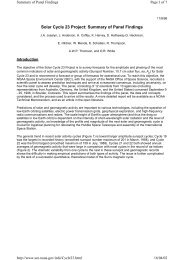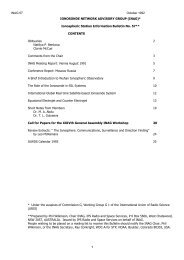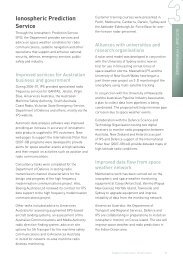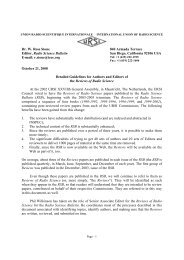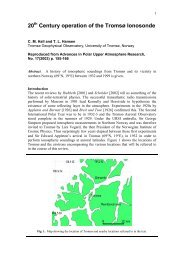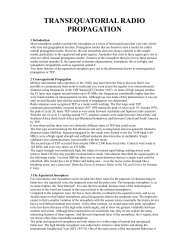UAG-93: Chapters 1 to 5 - URSI
UAG-93: Chapters 1 to 5 - URSI
UAG-93: Chapters 1 to 5 - URSI
You also want an ePaper? Increase the reach of your titles
YUMPU automatically turns print PDFs into web optimized ePapers that Google loves.
procedures employed with ordinary and with ordinary-p1us-extraordinary ray data. In these regions<br />
a single defined solution is generally not possible, so physicall-y desirable features are combined<br />
with the data in a least-square solution. Sections 4 <strong>to</strong> 9, and Appendices A <strong>to</strong> C, summarise much<br />
unpublished work which provides the basis for the techniques used in P0LAN. The practical use of<br />
P0LAN is described jn Section 10, while Section 11 describes a typical system for scaling, correction<br />
and analysi s of jonosonde data.<br />
Documentation of P0LAN and the associateo:,ubprograms is given in Appendices D <strong>to</strong> F; these<br />
provide logic flow tables, varjable descriptions and computer listings. Appendix G gives standard<br />
test data and the resulting output, so that correct operation of the main features of P0LAN can be<br />
verified. The data also illustrate some of the refjnements avajlable in POLAN for obtaining maximum<br />
.informatjon<br />
and accuracy in different situations. All proqrams and test data are available from World<br />
Data Center A.<br />
For a given set of viitual-height data, real-height analysis using P0LAN takes roughly twice<br />
as long as a simple lamination analysis. For a given overall accuracy, however, P0LAN requires<br />
only about half as many data points. Thus there is little final difference.in computing time, and<br />
there can be a worthwhile saving in the tjme required for scaling the ionograms. No problems have<br />
been found in running P0LAN on a minicompuler. About 40kB of memory are required with a PDP-11.<br />
The 24-bjt accuracy of such machines is sufficient for all modes of analysis, because of the stable<br />
procedure used <strong>to</strong> solve the simultaneous equations. Comparison of results from a PDP-11 and from a<br />
larger computer with 40-bit accuracy shows very few instances in which the calculated real heights<br />
differ by more than 0.001 km.<br />
In normal operation results are obtained using a polynomial representation of the real-height<br />
profile, fitted <strong>to</strong> several points each side of the section being calculated. This provides an<br />
accurate interpolation between scaled frequencies, which is necessary for an accurate analysis.<br />
Vr'rtual height data define pr.imarily the real-height gradients at the scaled frequencies. Real<br />
heights are therefore defined most accurately between the scaled frequencies (Titheridge, 1979).<br />
Thus when an accurate analysis is used <strong>to</strong> obtain real heights at the scaled frequencies, it is dealing<br />
directly with the most djfficult points. Tests have shown that direct second djfference interpolation<br />
is then sufficient <strong>to</strong> reproduce the profile between scaled frequencies with little or no increase in<br />
the mean error. Results obtained by P0LAN are therefore nornally s<strong>to</strong>red as arrays giving the scaled<br />
frequencies and corresponding real heights. Som extrapolated points are added above the layer<br />
peaks, for simpler calculation of mean profiles and <strong>to</strong> give smooth plots with second or third order<br />
parametric interpolation (which is necessary <strong>to</strong> cope with non-mono<strong>to</strong>nic profiles). The frontispiece<br />
shows some examples obtajned with fully au<strong>to</strong>matic processing and plotting of digital ionosonde data.<br />
For some purposes a mathematical representation of the calculated profiles is convenient.<br />
This has recently been provided for in POLAN, as outljned in section 2.4 and appendix G.3. The basic<br />
architecture of P0LAN is flexible and expandable. Further development depends on increased experience<br />
in defining physical constra.ints, on formulatlng judgement criteria for difficult conditions and<br />
specifying appropriate courses of action. Users of P0LAN can help in this development by informing<br />
the author of difficult data types, how these might be identified, and ways in which they might best<br />
be treated. Users are also urged <strong>to</strong> register wjth the author so that they will receive any further<br />
information on new developments or suggested pnogram changes.




